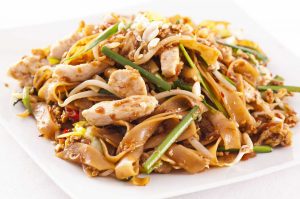1: Honey Glazed Salmon: I chose this dish because salmon is my favorite type of fish and a dish that I grew up eating on a regular basis
INGREDIENTS:
- 4 salmon filets
- Kosher salt and freshly ground black pepper, to taste
- 4 tablespoons all-purpose flour
- 4 tablespoons honey
- 2 tablespoons olive oil
- Zest of 1 lime
For the Brown Butter Lime Sauce:
- 6 tablespoons unsalted butter
- 2 cloves garlic, pressed
- 1 tablespoon honey
- Juice of 1 lime
- Kosher salt and freshly ground black pepper, to taste
DIRECTIONS:
- Preheat oven to 400 degrees F.
- To make the browned butter lime sauce, melt butter in a medium saucepan over medium heat. Cook, whisking constantly, until the foam subsides and the butter begins to turn a golden brown, about 3 minutes. Stir in garlic, honey and lime juice, salt and pepper, to taste; set aside.
- Season salmon with salt and pepper, to taste. Dredge each salmon filet with 1 tablespoon flour and drizzle with 1 tablespoon honey.
- Heat olive oil in a large oven-proof skillet over medium high heat. Working in batches, add salmon to the skillet and sear both sides until golden brown, about 1-2 minutes per side.
- Place into oven and bake until completely cooked through, about 8-10 minutes.
- Serve immediately with browned butter lime sauce and lime zest, if desired.
2: Bacon Stuffed Cheeseburger: I chose this dish because one of the things I talked about in my journal was the association between football and food. My friend who used to cook for us when we all went to his house on Sundays would always make bacon stuffed cheeseburgers
Ingredients
1 1/2 pounds ground beef
1 clove garlic, minced
1 teaspoon hot sauce (recommended: Frank’s Red Hot)
Salt and freshly ground black pepper
4 strips bacon, diced
1/2 onion, chopped
1 cup grated sharp Cheddar
4 burger buns
Lettuce, tomato, pickles for garnish
Directions
Preheat grill to medium.
In a bowl combine beef, garlic, hot sauce, salt and pepper, to taste, being careful not to over mix. Warm a skillet over medium heat and fry bacon until crispy. Remove to a paper towel-lined plate to drain. Keep heat on skillet and fry a pinch of the beef in the bacon fat to test seasoning. Adjust seasoning, if needed, then form 8 even thin patties, about 1/2-inch thick and set aside. Saute onions in bacon fat in skillet until tender, 5 minutes. Place onions and bacon in a bowl with cheese. Form a spoonful of bacon-cheese mixture into a ball, then place in the center of 4 patties. Top each with another patty and seal the edges. Grill burgers over medium-high heat, flipping once until desired doneness is reached, approximately 4 minutes each side for medium. Serve in buns with garnishes. Alternative: In a medium skillet over medium-high heat, sear the burgers 4 minutes on each side.
3: Chicken Pad Thai: I’ve always been a huge fan of Thai food and the first ever Thai food I had was chicken pad thai
Ingredients
- 10 oz Thai rice noodles
- 1 lb boneless skinless chicken breasts, sliced into small strips
- 2 Tbsp vegetable oil
- 1/4 cup packed dark-brown sugar
- 1/4 cup soy sauce
- 2 Tbsp rice vinegar
- 1 Tbsp lime juice
- 1 Tbsp fish sauce
- 1 red bell pepper, sliced into thin strips and strips halved
- 1 1/2 cups matchstick carrots
- 2 cloves garlic
- 4 green onions, whites minced, greens sliced into 1-inch pieces
- 2 cups bean sprouts
- 3 large eggs
- 1/2 cup unsalted peanuts, roughly chopped
- 1/3 cup cilantro, chopped
- Red pepper flakes and sesame seeds (optional)
Directions
- Prepare rice noodles according to directions listed on package. In a mixing bowl, whisk together brown sugar, soy sauce, rice vinegar, lime juice and fish sauce, set aside.
- While noodles are cooking, heat oil in a wok or large and deep non-stick skillet over medium-high heat. Once hot add chicken and saute until cooked through, about 4 – 6 minutes. Transfer to a plate, leaving oil in pan. Add bell pepper and carrots and saute 1 – 2 minutes then add garlic, green onions and bean sprouts saute 1 minute longer. Push veggies to edges of pan and crack eggs into center. Cook and scramble until eggs have cooked through. Add in chicken, noodles and sauce and toss everything together and cook 1 – 2 minutes.
- Serve warm topped with cilantro, peanuts and optional red pepper flakes and sesame seeds.
